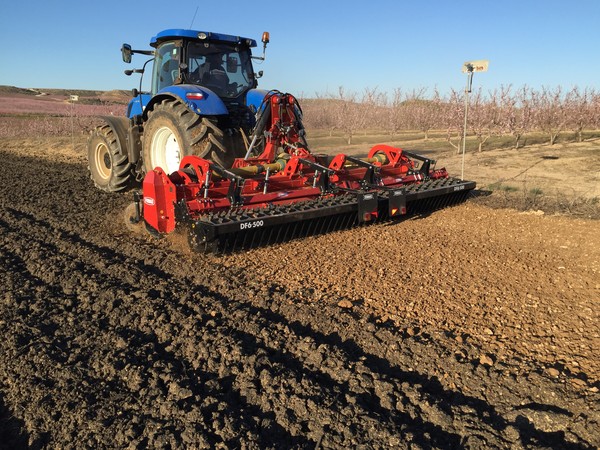
Technologies for optimal seed bed preparation
For several years, researchers and operators of the agricultural sector (each with their own skills and from complementary points of view) have participated in an important debate about the dualism between traditional soil processing techniques, i.e. the classic ploughing followed by harrowing, and those of minimum, strip or no-tillage, on which was the most appropriate choice both from the economic and, above all, from the environmental sustainability point of view
Ploughing is the operation par excellence of the traditional primary soil tillage; it allows the turning of the superficial layer of the soil (the so-called “fertile” one), and at the same time the incorporation of crop residues, allowing to get the benefit of maintaining a satisfactory level of soil organic matter. This intervention, however, involves the activation of aerobic processes that lead to a more rapid degradation of the latter and, consequently, to the need to make appropriate additions, with specific fertilizers and soil improvers. This is a major challenge for present and future agriculture. In addition, ploughing is a very energy-intensive operation, given that among all the periodic agricultural operations it often records the highest fuel consumption per unit area, requiring, among other things, the use of “big” tractors, therefore of medium-high power.
The refinement of the ploughed soil for the preparation of the seedbed (also called secondary processing) is then usually carried out with differently shaped harrows, divided into two main groups, the models with fixed or idle organs (which do not provide for the use of the power take-off, e.g. spring tine, spike-tooth, disc harrows) and, on the other hand, those which require power for the movement of elements, such as rotary harrows. On this matter, to identify the correct processing intensity (including the number of repetitions of the interventions), several variables must be taken into account. Among these, the texture of the soil, its humidity at the time of processing and the type of crop to be cultivated afterwards are of considerable importance. Clearly, each of the different harrow types highlights advantages and disadvantages, more or less amplified in each specific production field. Overall, rotary harrows, if correctly used, show a good capacity for refining the soil, even though they require medium-high power tractors, thus entailing high diesel consumption, with rather low operating capacities.
On the other hand, spike, spring harrows with rigid or idle teeth and disc harrows usually show a lower refinement efficiency, and often require more repetitions on the same plot, with a consequent lengthening of working time. In this case, however, medium-low power tractors, with relatively low fuel consumption, are usually enough.
Minimum soil tillage and sod-seeding
For several years, there has been a growing interest in minimum tillage solutions for seedbed preparation, which entail an undoubted simplification of the work organisation, with a simultaneous increase in work productivity. In addition to reducing the diesel consumption, being able to avoid plowing implies the absence of the formation of the typical processing sole that this operation causes; moreover, compaction is reduced and the organic matter degradation slows down, avoiding the need, both in terms of time and money, for a rather complex and demanding work site. The minimum soil tillage basic approach involves working the most superficial layer of the soil (up to 8-15 cm of depth), and sowing with seeders equipped with more solid tools than the traditional ones.
An alternative still keeping a very similar approach is the strip tillage one which, as the name suggests, requires the soil to be worked only in strips corresponding to the rows where the seeds will be subsequently laid.
Conversely, with the direct sowing, surface processing and sowing are carried out in a single passage, using a specifically designed seed drill to achieve this. Thanks to very strong working tools, the seed drill makes a small groove in the soil, where the seeds are laid. All of the remaining the land is not processed. Despite the benefits due to: i) the absence of ploughing; ii) a much more limited number of passages; iii) the increase in working speed, it must be said that not all crops are compatible with the minimum tillage, and above all, it is not so obvious that, as far as environmental sustainability is concerned, minimum soil tillage and sod-seeding are less impacting than the traditional processing (i.e. ploughing followed by one or more harrowing).
Assessment of environmental sustainability
All variables taken into account play a key role in the assessment of the environmental sustainability of soil processing. As for traditional work, the environmental impact of ploughing depends on the texture of the soil (loose, medium, or heavy consistency), on the type of plough chosen (number of ploughshares, mouldboards ploughs, slatted or disc ploughs) as well as the type of harrow (powered or not by the power take-off, heavier or lighter, etc.) and how many repetitions are needed. The texture of the soil is one factor that cannot be changed, and the intensity of the processing to be applied depends on it, thus remarkably conditioning the tractor power, its fuel consumption and, consequently, the exhaust gases emissions into the environment. Moreover, if the number of ploughshares (hence its working width) influences the working time and the power of the tractor to be coupled, the mass of the plough must be considered as well, since it must be distributed along the machinery lifespan. The same considerations can be applied on secondary tillage operations, where performing operations can be carried out in a single step but commonly consuming a lot of energy, and, on the other hand, low fuel consuming operations, that require many repetitions to assure a comparable processing quality. Life Cycle Assessment (LCA) is a method of analysis increasingly applied worldwide for this type of environmental sustainability assessment. It is a method of analysis standardized by ISO rules, which makes it possible to compare one or more operations characterized by the same reference unit, in order to identify which of them has the highest environmental impact, how much is the actual impact of the operation and which are the processes in the operation that have the greatest environmental importance. The analysis includes extraction, production, use, disposal of production inputs (for example, in the described cases: diesel fuel, lubricants, tractor and operating machine, fertilizers, etc.) and the emission of output into the air, soil and in water (for example: engine exhaust, nutrient leaching, etc.). The environmental impacts are calculated by dividing them on different impact categories, including, for example, global warming or carbon footprint, eutrophication, acidification, particulate and chemical smog formation, consumption of mineral and fossil resources, all factors able to represent the effects that all evaluated inputs and outputs cause to the environment. Precisely because we also consider the production, use and disposal of tractors and operating machines, in addition to the consumption of diesel and the emission of polluting gases coming from the engine combustion, the single machines mass plays a role on the environment too. In particular, its role’s size depends on the conditions of use and how many times the same plot requires to be worked; if, for example, for an optimal preparation of the seedbed it is required the intervention with two or more different harrows, the impact of secondary processing increases, because in addition to having to repeat the operation and therefore having to multiply the consumption of diesel fuel, we must also take into account the consumption of the machines, not only in terms of wear, but also in terms of impact due to construction, maintenance and replacement, as well as disposal at end-of -life. It also has to be taken into account that a machine at the end of its life that resulted underused causes a considerable impact, because its potential use has not been fully exploited. It should be emphasized that this always depends on the type of soil, the tractor appropriateness coupled to the operating machine, and on the operator’s driving skills. In turn, these variables influence others, more related to the tractor optimal functioning, and to the endothermic engine combustion process. Therefore, it is not always true that, from an environmental point of view, reducing the number of passages entails a better sustainability, therefore, the minimum processing does not always have a lower environmental impact than the traditional one. Ultimately, in any production context it is essential to evaluate in advance, with valid and recognized approaches, how and what operations are to be carried out, so as to be sustainable on many aspects as possible.








